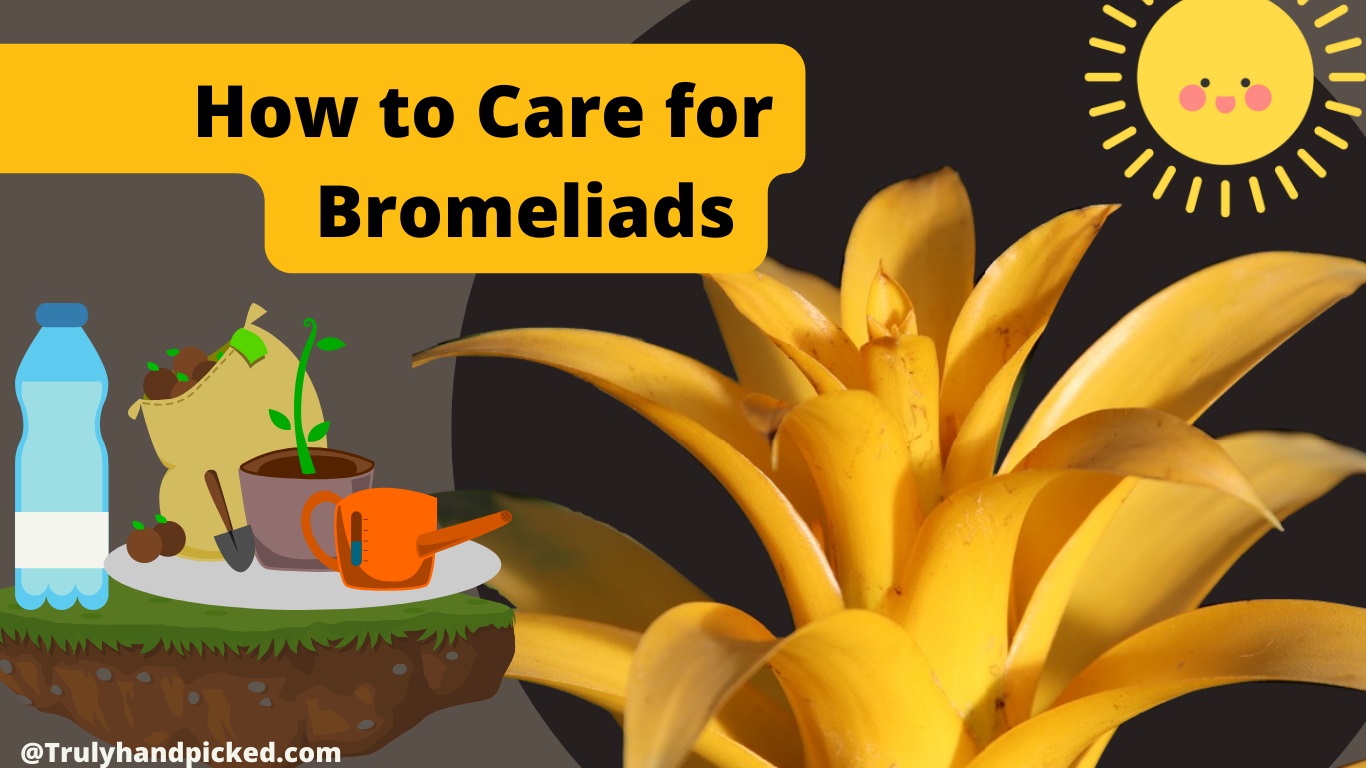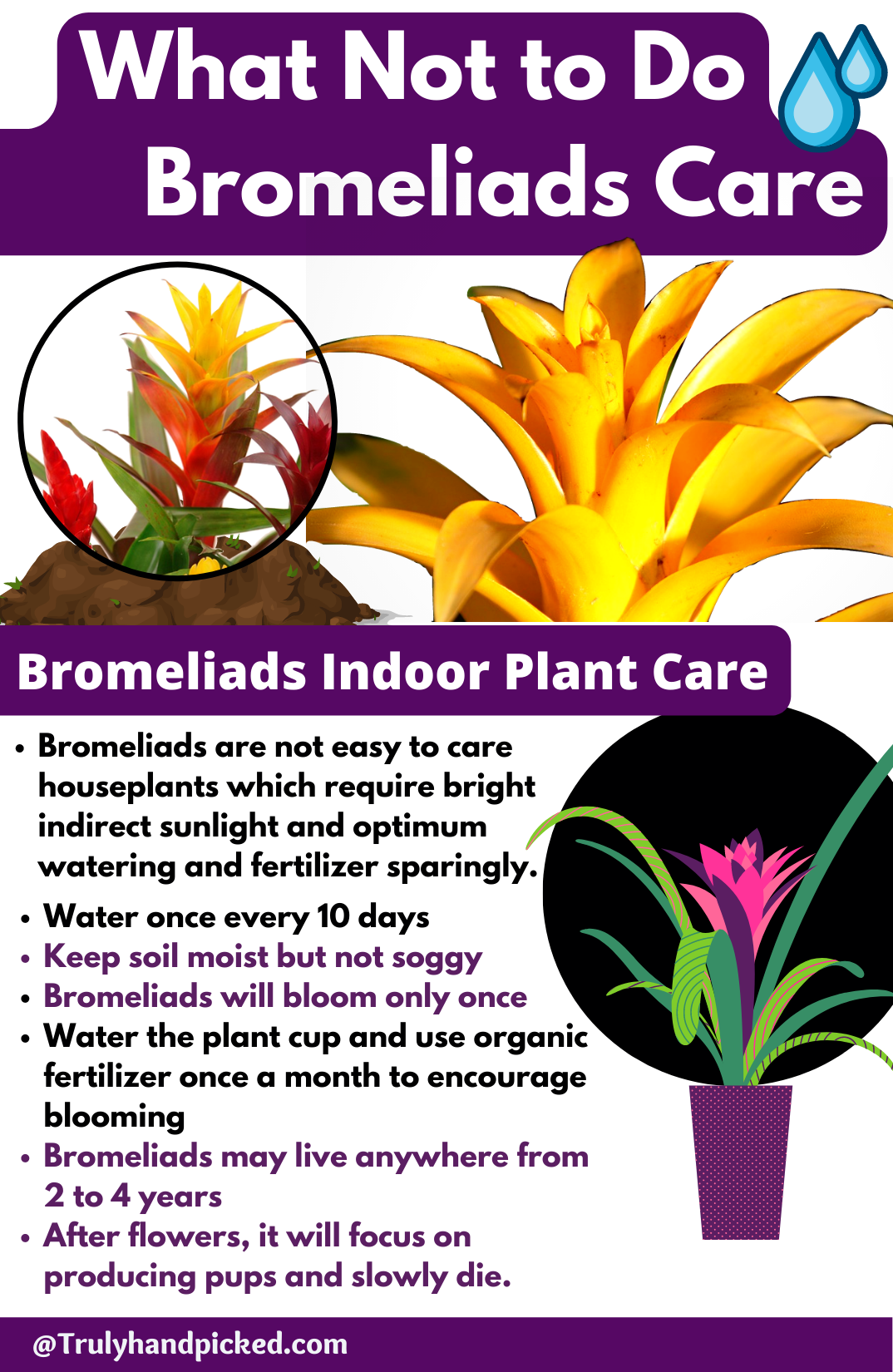Here you will find details on whether bromeliads can withstand full sun, and how often to water, soil, and fertilizer needs. Also on Bromeliads complete plant care, propagation, and FAQ (Toxic to pets?)
Bromeliads are not easy to care for houseplants which require bright indirect sunlight and optimum watering and fertilizer sparingly.
- Watering at regular intervals to keep the soil moist is enough rather than watering it to make it soggy. Check for proper drainage and pests to keep your bromeliads healthy and shine bright.
- Mostly bromeliads will bloom only once and if your young bromeliad is not blooming you can encourage it by keeping the center cup filled with clean water and fertilizing once a month with compost tea or organic plant food.
Bromeliads Plant Care
Bromeliads are a great houseplant to grow indoors, due to their striking resemblance. Apart from their shiny foliage, they produce inflorescence sections as blossoms in varieties of vibrant shades.
These are long-lived houseplants that stay for an elongated while once they grow and bloom properly. Due to being a slow-grower tropical indoor plant, bromeliads are quite particular about their basic needs.
Your bromeliads may live anywhere from 2 to 4 years and once they have reached their time they bloom. And the flowers last for 6 months, later it spends the rest of the time producing new baby plants called pups and slowly ends its chapter.
Can Bromeliads Take Full Sun
Yes, but half yes. Needs a sun and shade break.
Well, the answer is a bit tricky. While bromeliads love bright light, they prefer to have some shade or indirect sunlight rather than being directly under the scorching sun all day long.
Think of it like this: Bromeliads enjoy a sunny day at the beach, but they also need a cool umbrella to provide them with some shade. They like a balance between sun and shade, just like we do when we’re outside. It’s like finding the sweet spot where they can soak up enough light without getting sunburned.
If you expose bromeliads to full sun for too long, their leaves may get burnt and crispy, just like a potato chip in the oven for too long. Ouch! That’s not what we want for our bromeliads, right?
So, here’s what you can do: Find a spot for your bromeliads where they can get a good amount of sunlight during the day, but make sure they have some protection from the harsh, direct rays. It’s like giving them a cozy sunbathing spot under a shady tree or near a curtain that filters the sunlight.
By providing them with a little shade, you’re helping them stay happy and healthy, just like a good friend who looks out for you. They’ll still get the light they need to grow and thrive, but they won’t feel overwhelmed by the intense sun.
Remember, bromeliads are like sun-loving adventurers who enjoy a little shade break. So, give them a sunny spot with some shade, and they’ll reward you with their beautiful colors and cheerful presence.
So, you must know the proper growing requirements of this species of monocot family before picking one for your place. Here we emerge with some important facts about this beautiful houseplant in this regard-
How Often to Water Bromeliads?
Watering is a very delicate part of growing bromeliads as this category of tropical houseplant is a bit different from other common species. Bromeliads always seek evenly moist soil and a consistent watering system. So, if you have a set of growing bromeliads in-house, try to follow these watering tips attentively to get a healthy bunch of bromeliad plants naturally-
- Bromeliads contain a tank or cup part at the center of each plant. This specific section holds water for consistent water sully to the roots
- Fill that tank halfway when watering your bromeliads
- Make sure you change the excess water once a week to stop getting the root stagnated
- Always use distilled or filtered water to your growing bromeliads instead of normal tap water
- Try to gather rainwater in some places to water bromeliads, as these tropical plants thrive best with natural water sources
- Apply water with normal temperature, bromeliads are sensitive towards freezing water as well as warm water
- And always make sure that the excess water is draining well from the planters of bromeliads
- Also, overwatering is as bad as underwatering.
So, try to water your plant adequately and in time but never overdo it, if you want to get a happy experience at the end of the bromeliads planation.
Overwatered? Learn how to save a dying peace lily.
Are Bromeliads Toxic to Cats and Dogs?
Bromeliads are one of the safest houseplants you can grow indoors. This category of the tropical plant doesn’t contain any toxic or poisonous parts at all. So, you can feel relaxed and let your loving pet around your bromeliads plant without any worries.
However, you must take some elementary initiatives to keep both dogs and cats safe from the reach of your growing bromeliads plants. Some important notes a cat or dog owner always remember with growing bromeliads inhouse, are-
- You should not let your cat or canine gulp any part from your plant ever
- Bromeliads may be toxic-free but some house pets are allergic to its pollen parts
- On the other hand, house pets like cats and dogs won’t digest this greenery easily
- So, you must prevent your pets from swallowing leaves or stems from your bromeliad plants
- If you have baby pets like kittens or puppies, you must take extra care to keep them away from biting or gulping
- As sometimes, simple houseplants can turn venomous to a baby pet while reaching their stomach directly
- Besides, your loving cat or dog sometimes damages the growing bromeliads unknowingly with their sharp paws; so, keep the plant always out of their reach
- Finally, if you can’t place them on top, try to apply some separating barricades, which would be difficult for your house pets to cross easily.
Looking for indoor plants which are pet friendly – lookout for a list of pet-safe houseplants.
How to Care for Bromeliads:
Now, let’s lookout for the proper caring details of bromeliads plants to grow them indoors like an expert gardener-
Soil:
You need to seek fast-draining potting soil to plant bromeliads. Prepare your potting mix with peat moss, charcoal, perlite, and normal potting mix. Make sure you get rich, acidic, and evenly moist soil to get a healthy plant in the future. Keep the pH level between 5.0 to 6.0 for the best result.
Watering:
Bromeliads always want moist type soil that can retain the water consistently but never turn soggy. Water your plant once every other week or after 10-12 days to keep the condition as it prefers. Attempt to fill the inside cup once in every few whiles to keep the water consistency more natural for the plant.
Fertilizer:
Bromeliads are moderate feeders and always prefer low-nitrogen fertilizers. So, try to feed your bromeliad plant after every 2-3 weeks with a normal all-purpose fertilizer. Apply it in a 5-20-20 NPK ratio with one-eighth or one-quarter strength diluted forms. Don’t forget to skip fertilization during the winter season.
Lighting Requirements and Location:
Once you plant bromeliads properly, place the planters in a spot where they can get bright but indirect sunlight constantly. The light requirements of bromeliads are moderate, and they can stand different light intensities in different phases of growth. However, placing them in a south-facing window would be a good idea.
Preferred Climate:
Bromeliads are quite hardy and thus, tolerate low- to high temperature during their entire growing session. But, try to keep your plant under 60 to 80 degrees F temperature constantly, during the whole growing period. Plants can stand 60% humidity due to being tropical species. Try to bring your bromeliads out of the room frequently during summer to provide them with the best possible thrives naturally.
Pruning:
Pruning is essential for such shaggy houseplants. Wait till the foliage overgrows from the planter and the off-shoots outgrow the proper shape. After that period, trim off the dead and discolored leaves first with a sterilized cutter. Then go for the fully-grown-off shots and overgrown stems. Once you feel that the plant is in perfect shape again, hold your trimming for the next overgrown session and let the new shoot begin.
Get details and quick ideas on how to prune and propagate peace lily.
How to Propagate:
Propagation is quite difficult for bromeliads, unlike other common houseplants. However, you can do this effortlessly by our below instructions. All you need to do is that wait for the reporting period and follow these simple steps accordingly-
- Take out fully grown bromeliads from their current planter and division them tidily
- The core of the bromeliads is tough, separates the pups, and keeps the roots untouched
- Clear off the bottom part a little bit and lose the soil properly before going for the replantation
- Make sure you keep the newly grown pups for propagation and throw the older ones away
- Now all you need to do is that repot them up properly with their roots undamaged
- Bring the planters with prepared potting soil and sow them up directly
- Water your newly planted offsets and let them thrive naturally under a perfect growing climate.
Pinterest Bromeliads Care Infographic Image
Quick tips on bromeliad care
- Try to look after the common bromeliad pests like aphids, scale, mealybugs, etc., and apply remedies immediately
- Avoid using chemical-based pesticides and go for organic options like neem oil, vinegar, rubbing alcohol, etc.
- Watch out for fungal or bacterial infestation on soil and the sap of the plants
- Keep the watering amount perfect as over or underwatering can rot the roots of your growing plants
- Repot your plants once every 2-3 years only if it seems to be needed, as they don’t have a larger root system they are happy with a medium-sized pot for their lifetime.
- And always pick those species of bromeliads, which are easy-go-grow indoors as a houseplant. Neoregelia, guzmania, annas, vriesea, etc. are some good option to pick here.




